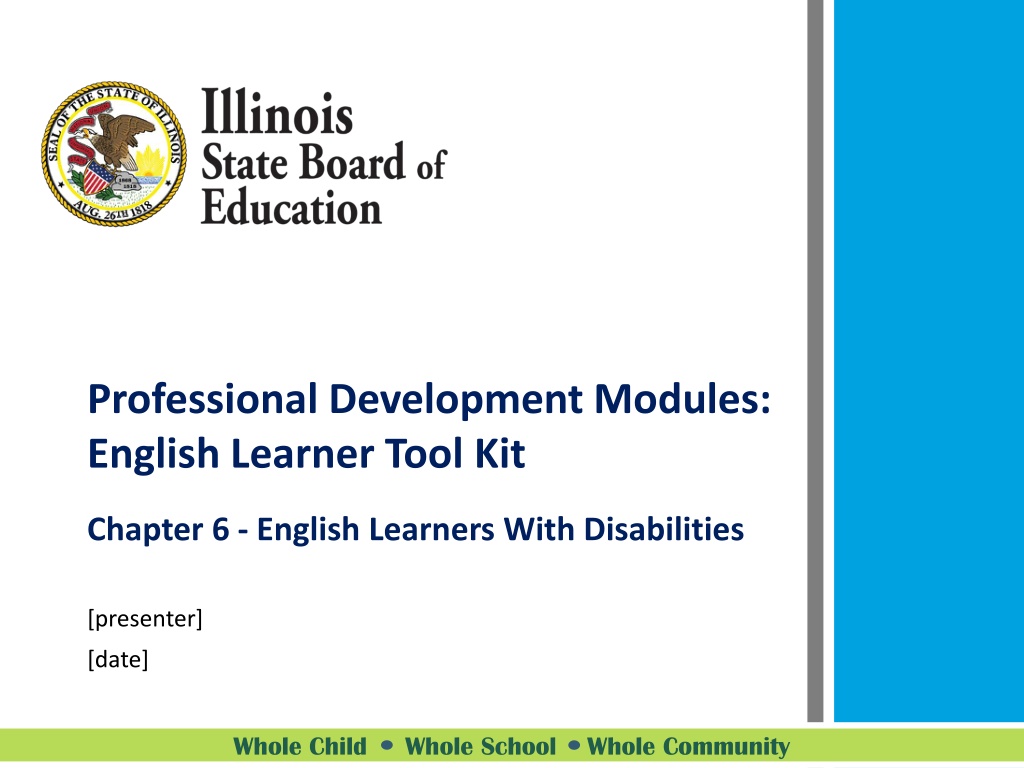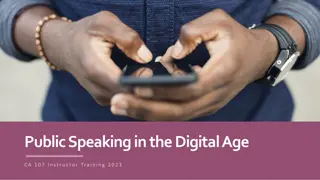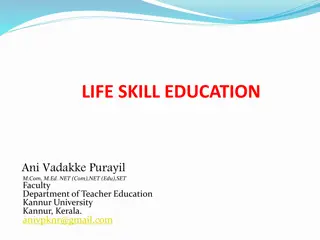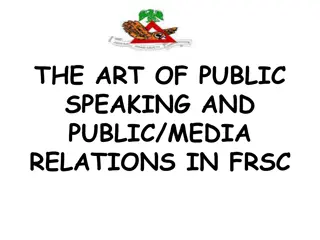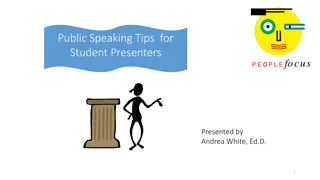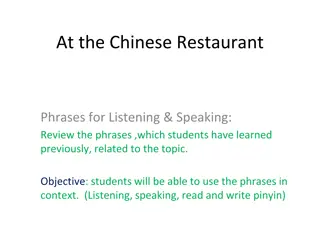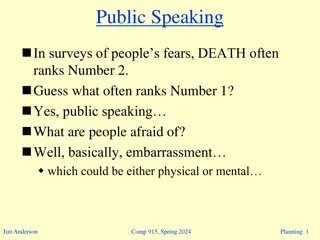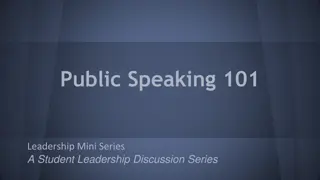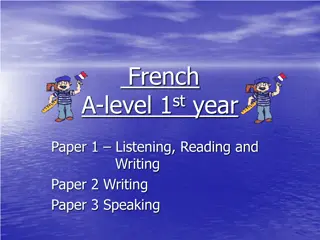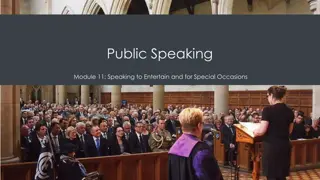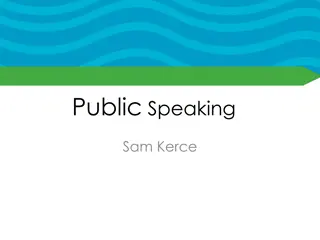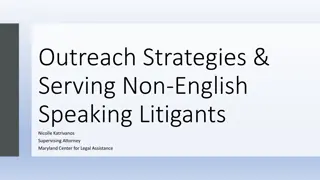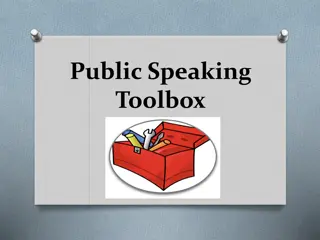Enhancing Informative Speaking Skills
Informative speaking involves sharing knowledge by defining, illustrating, and clarifying topics to enhance audience understanding and retention. Different types of informative speeches and strategies to enhance audience understanding are discussed.
Uploaded on Feb 27, 2025 | 0 Views
Download Presentation

Please find below an Image/Link to download the presentation.
The content on the website is provided AS IS for your information and personal use only. It may not be sold, licensed, or shared on other websites without obtaining consent from the author.If you encounter any issues during the download, it is possible that the publisher has removed the file from their server.
You are allowed to download the files provided on this website for personal or commercial use, subject to the condition that they are used lawfully. All files are the property of their respective owners.
The content on the website is provided AS IS for your information and personal use only. It may not be sold, licensed, or shared on other websites without obtaining consent from the author.
E N D
Presentation Transcript
Professional Development Modules: English Learner Tool Kit Chapter 6 - English Learners With Disabilities [presenter] [date] Whole Child Whole School Whole Community
Purpose 2 The Professional Development Modules: English Learner Tool Kit is a series of presentations intended to provide guidance to help local education leaders meet their legal obligations to English learners (ELs) and enhance existing EL practices to meet the needs of all EL students, parents, and families. Whole Child Whole School Whole Community Whole Child Whole School Whole Community
English Learner Tool Kit Topics 1. Identifying All ELs 2. Language Assistance Programs 3. Staffing and Supports 4. Meaningful Access 5. Inclusive Environment 6. ELs With Disabilities 7. ELs Who Opt Out of Programs 8. Monitoring and Exiting EL Programs 9. Evaluation of EL Programs 10.Communication With EL Parents Whole Child Whole School Whole Community Whole Child Whole School Whole Community
Significant Legal History 4 Title VI of the Civil Rights Act, 1964 Prohibits discrimination on the grounds of race, color, or national origin by recipients of federal financial assistance. The Title VI regulatory requirements have been legally interpreted to prohibit denial of equal access to education because of a language minority student's limited proficiency in English. Whole Child Whole School Whole Community Whole Child Whole School Whole Community
Significant Legal History 5 Lau v. Nichols Court Case, 1974 Case dealt with San Francisco school system s failure to provide English language instruction to 1,800 students of Chinese ancestry. U.S. Supreme Court unanimously ruled that a lack of supplemental instruction for ELs denies them a meaningful opportunity to participate in education programs, which violates the Civil Rights Act of 1964. Whole Child Whole School Whole Community Whole Child Whole School Whole Community
Significant Legal History 6 Equal Educational Opportunities Act (EEOA), 1974 Prohibits states from denying equal educational opportunity to an individual on account of his or her race, color, sex, or national origin. The statute specifically prohibits states from denying equal educational opportunity by the failure of an education agency to take appropriate action to overcome language barriers that impede equal participation by its students in its instructional programs. Whole Child Whole School Whole Community Whole Child Whole School Whole Community
There is no equality of treatment merely by providing students with the same facilities, textbooks, teachers, and curriculum; for students who do not understand English are effectively foreclosed from any meaningful education. Justice William Douglas
Legal Obligations 8 U.S. Department of Education s Office of Civil Rights (OCR) and the U.S. Department of Justice (DOJ) share enforcement authority. Issued joint guidance in 2015 to help states, districts, and schools meet legal obligations to ELs. Guidance identifies 10 common civil rights issues for ELs. Whole Child Whole School Whole Community Whole Child Whole School Whole Community
Addressing English Learners With Disabilities Whole Child Whole School Whole Community Whole Child Whole School Whole Community
English Learner Tool Kit Chapter 6: Tools and Resources for Addressing English Learners With Disabilities 10 KEY POINTS: Local education agencies (LEAs) must identify, locate, and evaluate ELs with disabilities in a timely manner. LEAs must consider the English language proficiency of ELs with disabilities in determining appropriate assessments and other evaluation materials. LEAs must provide and administer special education evaluations in the child s native language, unless it is clearly not feasible to do so, to ensure that a student s language needs can be distinguished from a student s disability-related needs. LEAs must not identify or determine that EL students are students with disabilities because of their limited English language proficiency. LEAs must provide EL students with disabilities with both the language assistance and disability-related services they are entitled to under federal law. Whole Child Whole School Whole Community Whole Child Whole School Whole Community
English Learner Tool Kit Chapter 6: Tools and Resources for Addressing English Learners With Disabilities 11 KEY POINTS: LEAs must identify, locate, and evaluate ELs with disabilities in a timely manner. LEAs must consider the English language proficiency of ELs with disabilities in determining appropriate assessments and other evaluation materials. LEAs must provide and administer special education evaluations in the child s native language, unless it is clearly not feasible to do so, to distinguish students language needs from disability-related needs. Whole Child Whole School Whole Community Whole Child Whole School Whole Community
English Learner Tool Kit Chapter 6: Tools and Resources for Addressing English Learners With Disabilities 12 KEY POINTS: LEAs must not determine that ELs have disabilities because of their limited English language proficiency. LEAs must provide ELs with both the language assistance and disability-related services they are entitled to under federal law. Whole Child Whole School Whole Community Whole Child Whole School Whole Community
Illinois Requirements Whole Child Whole School Whole Community
Two Sets of Legal Requirements 14 Students with special education needs Holistic supports English learners Whole Child Whole School Whole Community Whole Child Whole School Whole Community
Child Find Responsibility 15 Districts must actively seek out all children birth age 21 who may be eligible for special education. Procedures must include: Annual and ongoing screenings of children under age 5. Ongoing review of each child s performance and progress by teachers or other professional personnel. Ongoing coordination with early intervention programs to identify children birth age 2 who might have disabilities. Whole Child Whole School Whole Community Whole Child Whole School Whole Community
Before the Special Education Evaluation Districts must determine the child s English language proficiency (ELP) 16 Use this information in case study and later in IEP development and implementation Screening for ELP (dependent on HLS results) EL designation (dependent on screening results) Home Language Survey (HLS) Whole Child Whole School Whole Community Whole Child Whole School Whole Community
Case Study Evaluation 17 Disability evaluation must be: Nondiscriminatory with respect to language, culture, race, and gender; Relevant to students culture and consistent with their primary language/mode of communication; and Conducted by a qualified bilingual specialist. If conducted under nonstandard conditions, a description must be included in the evaluation report. Whole Child Whole School Whole Community Whole Child Whole School Whole Community
An IEP shall be considered linguistically and culturally appropriate if it addresses the language and communication needs of a student as a foundation for learning, as well as any cultural factors that may affect the student s education. (34 CFR 300.22)
IEPs for EL Students 19 A statement about the languages or modes of communication in which special education and related services will be provided must be included. The language needs of the child must be considered, in particular the student s English proficiency level. The child is entitled to both special education services and language development services. Special education services may be provided in a language other than English. Whole Child Whole School Whole Community Whole Child Whole School Whole Community
Parent Meeting Participation 20 Districts must facilitate parent understanding of and participation in IEP meetings. This includes interpretation for parents whose native language is not English. Whole Child Whole School Whole Community Whole Child Whole School Whole Community
Parent Meeting Participation 21 School districts can employ personnel who speak languages common in their student populations, provide interpreter training, and develop a list of interpretation and translation services. Whole Child Whole School Whole Community Whole Child Whole School Whole Community
Pause and Reflect 22 In our district/school, are needs evaluations based on students suspected need rather than their ELP? How do we ensure that our IEP teams include participants who: Have knowledge of students language needs? Have training in special education and related services? Have training in second language acquisition and EL services? Understand cultural differences? Whole Child Whole School Whole Community Whole Child Whole School Whole Community
Pause and Reflect (Continued) 23 How do we involve parents in the IEP process in a language they understand? Beyond the legal requirements, how might our processes be made more clear and supportive for students and families? Whole Child Whole School Whole Community Whole Child Whole School Whole Community
Additional Resources to Consider From the EL Tool Kit Whole Child Whole School Whole Community Whole Child Whole School Whole Community
Resources on ELs With Disabilities 25 In the EL tool kit, https://www2.ed.gov/about/offices/list/ oela/english-learner-toolkit/chap6.pdf: Tool #1: Policy Recommendations for Referral, Identification, Assessment, and Service Delivery to ELs With Disabilities Tool #2: Language Differences Versus Disabilities Matrix Tool #3: Developing an IEP for an English Learner With a Disability Checklist Tool #4: How to Use Data From the Office for Civil Rights Tool #5: Dos and Don ts for Selecting Appropriate Accommodations for Students With Disabilities Illinois special education notice and consent forms and translations: https://www.isbe.net/Pages/Special-Education- Required-Notice-and-Consent-Forms.aspx Whole Child Whole School Whole Community Whole Child Whole School Whole Community
Tools for Addressing English Learners With Disabilities 26 Tool #1 Referral, Identification, Assessment, and Service Delivery to ELs With Disabilities Includes recommendations about ELs with disabilities from states with large or rapidly growing EL student populations. Whole Child Whole School Whole Community Whole Child Whole School Whole Community
Tools for Addressing English Learners With Disabilities 27 Tool #2 Considering the Influence of Language Differences and Disability on Learning Behaviors Offers a matrix of learning behaviors organized by skill area (e.g., listening, speaking, reading) and the varying roles that language difference or disability can play in those behaviors. Whole Child Whole School Whole Community Whole Child Whole School Whole Community
Tools for Addressing English Learners With Disabilities 28 Tool #3 Developing an IEP for an English Learner With a Disability This checklist of questions contain considerations for ELs during the IEP-writing process. Whole Child Whole School Whole Community Whole Child Whole School Whole Community
Tools for Addressing English Learners With Disabilities 29 Tool #4 How to Use Data From the Office for Civil Rights Civil Rights Data Collection (CRDC) This tool provides instructions about how to access EL data at the district level, including data about ELs with disabilities. Whole Child Whole School Whole Community Whole Child Whole School Whole Community
Tools for Addressing English Learners With Disabilities 30 Tool #5 Selecting Appropriate Accommodations for Students With Disabilities This list of dos and don ts will provide guidance when choosing accommodations for students with disabilities. Whole Child Whole School Whole Community Whole Child Whole School Whole Community
Background Resources 31 Fact sheet on the responsibilities of school districts Fact sheet answering common questions about the rights of limited-English-proficient parents and guardians Original OCR/DOJ guidance in the Dear Colleague letter Translations into multiple languages All available at: https://www2.ed.gov/about/offices/list/ocr/ellresources.html Companion tool kit from the U.S. Department of Education s Office of English Language Acquisition: https://www2.ed.gov/about/offices/list/oela/english-learner- toolkit/index.html Whole Child Whole School Whole Community Whole Child Whole School Whole Community
Further Reading Abadeh, H. (2015). Home-school communications: Multicultural parents of children with disabilities. NABE Journal of Research and Practice, 6. Retrieved from https://www2.nau.edu/nabej-p/ojs/index.php/njrp/article/view/91/73 32 Abedi, J. (2006). Psychometric issues in the ELL assessment and special education eligibility. Teachers College Record, 108(11), 2282 2303. Retrieved from http://www.ncaase.com/docs/Abedi_TCRE782_2006.pdf Adelson, V., Geva, E., & Fraser, C. (2014). Identification, assessment, and instruction of English language learners with learning difficulties in the elementary and intermediate grades. Toronto, Ontario, Canada: University of Toronto, Ontario Institute for Studies in Education, Applied Psychology and Human Development. Retrieved from http://www.ctserc.org/assets/documents/initiatives/specific-learning-disabilities- dyslexia/archive/ELLs-with-special-needs.pdf Albus, D., Thurlow, M., & Clapper, A. (2007). Standards-based instructional strategies for English language learners with disabilities. Minneapolis, MN: University of Minnesota, National Center on Educational Outcomes Retrieved from http://www.cehd.umn.edu/NCEO/Onlinepubs/ELLsDis18/ELLsDisRpt18.pdf Burr, E., Haas, E., & Ferriere, K. (2015, July). Identifying and supporting English learner students with learning disabilities: Key issues in the literature and state practice. U.S. Department of Education, Institute of Education Sciences, National Center for Education Evaluation and Regional Assistance, Regional Educational Laboratory West. Retrieved from http://ies.ed.gov/ncee/edlabs/regions/west/pdf/REL_2015086.pdf Whole Child Whole School Whole Community Whole Child Whole School Whole Community
